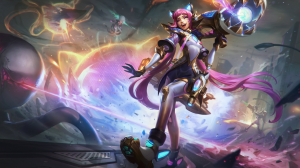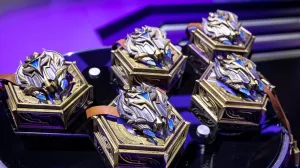To see if a bet is worth taking, approach it from the perspective of expected value. To calculate the expected value of a potential bet, you need two things: the payout if you win and your probability of winning. But, while we’ve talked a lot about the payout (how to understand it, how it’s reduced, how to get market probabilities out of it), we’ve glossed over the second piece so far. And now it’s finally time to talk about where the probability side of the equation comes from and why it’s so important to have an independent view of these probabilities.
Market Probabilities
The most direct way to get a read on how likely each team in a match is to win is from the odds themselves. Oddsmakers have their own initial probabilities from which they determine what odds to offer on any given match. However, as we’ve talked about in a prior article, the vig ensures that using these probabilities always results in negative expected value.
We had given an example of this before, but we can formally prove it. You’re given the payout, p, of a bet. From this, you can get the implied probability, WI:
WI = 1 / p
Given a positive vig, the true probability WT of the bet must be less than WI, so WT < WI. This is provable from the definition of vig and normalized probability, but we’ll skip that here for conciseness. Intuitively, odds are paid out as if an event was more likely to occur than it actually is, since oddsmakers pay out less than is fair. Going through the EV calculation:
EV = WT * (p – 1) + (1 – WT) * (-1)
Since WI = 1 / p, we can substitute p = 1 / WI:
EV = WT * (1 / WI – 1) + (1 – WT) * (-1)
EV = WT / WI – WT – 1 + WT
EV = WT / WI – 1
Since WT < WI, then WT / WI < 1, so WT / WI – 1 < 0, and therefore EV is negative.
Believable probabilities
So, for us to believe we have positive EV on a bet, we have to have a different view of the probabilities of an outcome than the odds market does. We have to be very careful with this. It’s easy to just come up with a probability such that the EV is positive (trivially, if your probability of success is 100%, you’ll always make money).
We don’t just want to have positive EV; we want to have positive EV that we believe. We can define this backwards: if we believe this probability, and the EV given this probability is positive, then this bet is worth making. So, we need to have our own view of the probability of an event. We need to believe that probability is correct and that probability needs to be different enough from the market to generate positive value.
Market incentives
Being both right and in disagreement with the market is hardly a guarantee. The odds market is fairly efficient, after all. Otherwise, oddsmakers wouldn’t be making money. But, how can they be wrong often enough for us to find consistent value?
The answer lies in market incentives. The job of an oddsmaker isn’t to be as accurate as possible to the true outcomes of esports matches; it’s to make money. It is much safer to consistently make guaranteed money by matching up potential bettors with each other and just charging them a vig than to actually take the other side of bets against bettors.
This is called “balancing your book.” Imagine Team A and Team B are playing against each other. A bet on Team A is paying out 1.41 and a bet on Team B is paying out 2.82. A bunch of people place bets on either side and, in total, $2000 is wagered on Team A and $1000 is wagered on Team B.
If Team A wins, the oddsmaker pays out a total of $2000 * 1.41 = $2820 to people who wagered on Team A. Since a total of $3000 was wagered, the oddsmaker keeps the $180 difference. If Team B wins, the oddsmaker pays out a total of $1000 * 2.82 = $2820 to people who wagered on Team B. They keep the same $180. The bets were perfectly balanced, so the oddsmaker does not care at all which team wins. They take their guaranteed profit either way.
What if only $1000 had been bet on Team A and the same $1000 on Team B? Then, if Team A won, the oddsmaker would have to pay out $1410 to Team A bettors and keep $590 in differential. However, if Team B won, the oddsmaker would pay out $2820 to Team B bettors off of a total of $2000 in wagers, so it would lose $820 out of its own pocket. In this situation, the oddsmaker has exposure to the match — it cares about the actual outcome.
This is bad for them. Sure, the oddsmaker probably comes out ahead in the long run because they’re just placing direct bets with their customers but get the benefit of a vig. However, they’re trying to run a matchmaking service, not a casino. They’re ok taking some exposure because it’s unavoidable. But they’re generally trying to avoid it because the vig only gives them positive expected value if their predictions are correct. If their predictions are slightly off but they can maintain a balanced book, then it doesn’t actually matter that the predictions weren’t perfect. They get paid either way.
So, how does an oddsmaker try to balance their book? They have to get potential bettors to bet on both sides such that the payouts are equal. If not enough people are betting on Team A, they adjust their odds to attract more attention to that side. If they move the odds too much, they can end up balanced but with no guaranteed profit, so it’s much safer to make sure that their initial odds are reasonable enough that they don’t have to move much.
This is the crux of the matter. Reasonable odds aren’t odds that are accurate to reality; they’re odds that line up well with the average perception of bettors. If an oddsmaker thinks that Team A has a 75% chance to win but the average sentiment of bettors is that they have a 67% chance to win, the oddsmaker will set their line at 67/33 (plus vig). This is because that is what will make sure their book is balanced.
Had they set it at 75/25, too many people would bet on Team B (believing that they should have a 33% chance to win, not the 25% implied by the market), and the oddsmaker would take on exposure.
This is exactly why there’s opportunity for a systematic bettor to find value. The market may seem mispriced because their model is wrong in some fundamental way, but it may seem mispriced also because they are tracking the overall sentiment of their customers, and you have some differential view to them.
Most of these bettors are wagering based on instinct, not rigorous quantitative analysis, so it’s easier to accept that they could be wrong. There is obviously a high degree of correlation between what bettors think the fair probabilities are and what they actually are, but your average person doesn’t have a very good understanding of the difference between a 70/30 matchup and a 75/25 one, other than that “they’re both pretty lopsided.”
Blind analysis
Before you look at whether or not the market is mispriced, it’s important to already have your own prediction.
It’s too easy to look at market implied probabilities and think, “yeah, that sounds about right.” Market odds, as mentioned above, are literally structured and chosen such that they feel right. There’s a certain appeal to authority where you’re disinclined to think that an oddsmaker can be completely wrong in their prediction.
In psychology, this is called anchoring. Let’s say you generally think Team Liquid are favored against Cloud9. You look at the odds market and implied odds put them right at 50/50. You might then decide that your overall intuition is still correct and that maybe the fair probabilities are 55/45. You’re abiding by your overall intuition but, because you’ve already been anchored to the 50/50 point, you don’t want to stray too far from it because it sounds unreasonable to disagree that much.
In reality, had you just done your own analysis without ever looking at anyone else’s. You may have arrived at 65/35, for example. By seeing the market’s perspective, you’ve potentially deprived yourself a lot of value, assuming your actual analytical approach is fundamentally sound.
That isn’t to say you should never look at the analysis of others. If you have consistently different predictions than anyone else, that’s a red flag that something is wrong in your model. However, it’s important to keep that comparison to post-facto analysis, and not let it sway your decision making in the short term.
Getting predictions
To recap: to generate betting value, you need to both disagree with the market and, on average, be correct in your disagreement. You need to generate your predictions in isolation and then compare them with the market to see if you can find EV-positive bets. There is room for this because odds markets are designed to reflect the average consensus of the masses; not necessarily their own beliefs about match outcomes.
This all sounds nice in theory but, once again, it feels as though we’ve glossed over an important step. How do you generate your own predictions that you have confidence in?
If it was easy, everyone would do it. That’s where we come in. Alacrity.gg is built on a rigorous quantitative model that ticks all of those boxes, and it powers every bet suggestion you see here on Upcomer.








